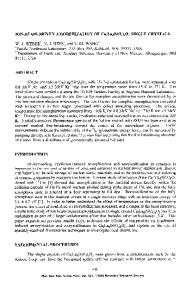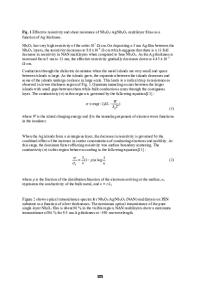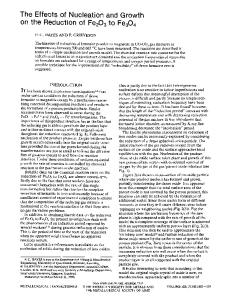Effects of annealing temperature on the structure and photoluminescence properties of the ZnO/ZnAl 2 O 4 /Ca 5 Al 6 O 14
- PDF / 2,758,807 Bytes
- 11 Pages / 595.276 x 790.866 pts Page_size
- 32 Downloads / 275 Views
Effects of annealing temperature on the structure and photoluminescence properties of the ZnO/ZnAl2O4/Ca5Al6O14/ Ca3Al4ZnO10:0.1% Ce3+ mixed‑phases nanophosphor prepared by citrate sol–gel process M. N. Mphelane1 · M. R. Mhlongo1 · T. E. Motaung2 · L. F. Koao3 · T. T. Hlatshwayo4 · Setumo Victor Motloung1,5 Received: 15 January 2020 / Accepted: 16 September 2020 / Published online: 28 September 2020 © Springer-Verlag GmbH Germany, part of Springer Nature 2020
Abstract Mixed-phases of the undoped ZnAl2O4/ZnO/Ca5Al6O14 (ZZC) and Ce3+ doped ZnAl2O4/ZnO/Ca5Al6O14/Ca3Al4ZnO10 (ZZCC:0.1% Ce3+) were successfully prepared using the sol–gel method. The 0.1% Ce3+ concentration was kept constant while the annealing temperature (Ta) was varied from 500 to 1300 °C. X-ray diffraction (XRD) results showed that the prepared materials consist of the mixture of the cubic (ZnAl2O4), hexagonal wurtzite (ZnO) and orthorhombic (Ca5Al6O14 and Ca3Al4ZnO10) crystal structures, which highly depends on the Ta. Energy dispersive x-ray spectroscopy (EDS) analysis confirmed the presence of all the expected elementary compositions. Scanning electron microscopy (SEM) results showed that varying the Ta does not influence the morphology of the prepared nanophosphor material. Transmission electron microscopy confirmed that the prepared powders were in the nanoscale region. The photoluminescence (PL) results showed emission peaks located at 409, 488, 545, 589, 615, 695 and 785 nm, which were attributed to the intrinsic defects within ZZC mixed phases. There was no emission observed from the C e3+ transition. Optimum photoluminescence intensity was observed at the Ta = 600 °C. The commission Internationale de I’Eclairage coordinates (CIE) showed that the emission colour could be tuned by varying the Ta. Keywords Sol–gel · Spinel · Ce3+-doped · Luminescence · CIE
1 Introduction Recently nanoparticles research is currently an area of substantial scientific interest to researchers. In particular, metal oxide nanoparticles have received research attention due to their remarkable optical, electrical, magnetic * Setumo Victor Motloung [email protected] 1
Department of Physics, Sefako Makgatho Health Science University, Medunsa 0204, South Africa
2
Department of Chemistry, University of Zululand, KwaDlangezwa 3886, South Africa
3
Department of Physics, University of the Free State (Qwaqwa Campus), Phuthaditjhaba 9866, South Africa
4
Physics Department, University of Pretoria, Pretoria, South Africa
5
Department of Physics, Nelson Mandela University, Port Elizabeth 6031, South Africa
and catalytic properties [1]. Metal oxide nanoparticles such as zinc oxide (ZnO) with a bandgap of Eg ~ 3.37 eV [2], can be used in light-emitting diodes (LEDs), transport electrodes, liquid crystals and solar cells [3, 4]. ZnO has been reported [3–5] to emit intrinsic luminescence in the green spectral range and minor emission in the red spectral region. These emissions are due to deep defects such as oxygen and zinc vacancies and impurities. Ot
Data Loading...











